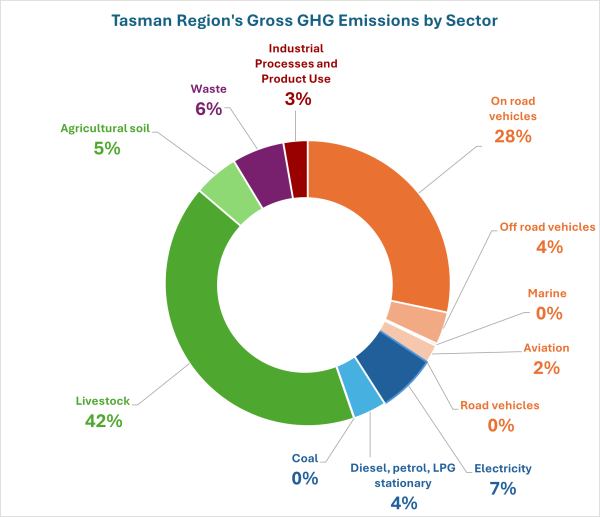Learn more about:
Our Tasman Climate Response and Resilience Strategy and Action Plan 2024-2035 includes the following emissions reduction goals and targets:
Council and Tasman District collectively contribute to New Zealand's efforts to reduce greenhouse gas emissions.
1(a) Biogenic methane emissions reduce by 10% below 2017 levels by 2030 and 24-47% by 2050 or earlier.
1(b) Net emissions of all other greenhouse gases reduce to zero by 2050.
1(c) Net emissions of all other greenhouse gases from Council's activities reduce 43% by 2030 and 65% by 2035, compared to the 2020/21 baseline to align with New Zealand's commitments.
Note:
Targets 1(a) and 1(b) are the government targets specified in the Climate Change Response Act (Part 1B) and therefore apply to both the entire Tasman District and Council's activities.
Target 1(c) specifies interim targets for Council's emissions for intervening years.
The Council knows how important reducing our greenhouse gas (GHG) emissions are, and we are committed to reducing our own footprint.
You can read our GHG emissions inventory reports here:
We will continue to report on our emissions annually and update you on this page.
We work together with Nelson City Council and the Nelson Tasman Climate Forum to measure and report on regional GHG emissions.
A baseline report has been produced for financial years 2018/19 and 2019/20:
During the 2018/19 reporting period, the total gross GHG community emissions from the Tasman region were 832,590 tCO2e, which equates to 15.3 tCO2e/person.
During the 2019/20 reporting period, the total gross GHG community emissions from the Tasman region were 763,389 tCO2e, which equates to 13.6 tCO2e/person.

Agriculture was the largest GHG community emission emitting sector for both years, producing 45.8% of Tasman’s total gross GHG emissions in 2018/19 and 46.6% in 2019/20. Livestock produced the majority of the agriculture sector’s GHG emissions (89.8% of the agriculture sector’s GHG emissions in 2018/19 and 89.1% in 2019/20).
The majority of livestock in Tasman are sheep, accounting for 81.1% of farmed livestock in 2018/19 and 81.2% in 2019/20. Enteric fermentation from livestock (i.e. methane released by their digestive systems) produced 321,615 tCO2-e (84.4%) of agriculture emissions in 2018/19 and 299,360 tCO2-e (84.2%) in 2019/20. The second largest source of agriculture emissions was from nitrous oxide (N2O) being released by urine and dung deposited by grazing animals (36,381 tCO2-e in 2018/19 and 36,434 tCO2-e in 2019/20).
Transport (e.g. road and air travel) was the second largest GHG community emission emitting sector for both years, producing 34.4% of Tasman’s total gross GHG emissions in 2018/19 and 34.3% in 2019/20. Petrol and diesel use contributed 91.3% of the Transport sector’s GHG emissions in 2018/19 and 93.3% in 2019/20. Petrol and diesel transport GHG emissions can be broken down into:
